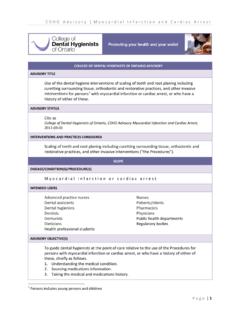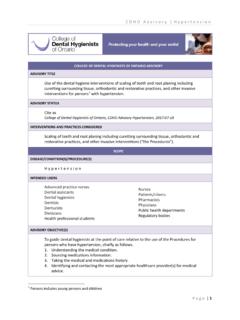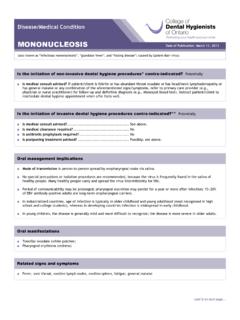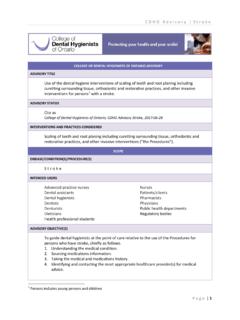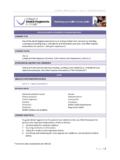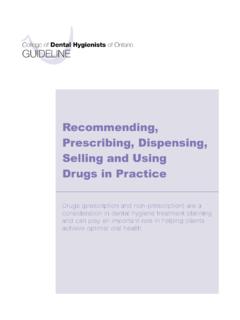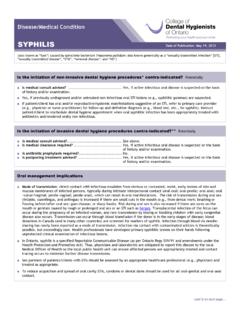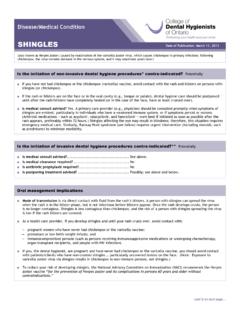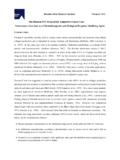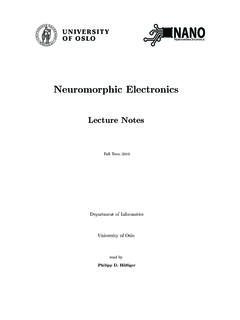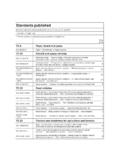Transcription of CDHO Factsheet COPD
1 Cont d on next Disease/Medical Condition CHRONIC OBSTRUCTIVE PULMONARY DISEASE (also known as copd , chronic obstructive lung disease , COLD , and emphysema + chronic bronchitis ) Date of Publication: August 27,2015 Is the initiation of non-invasive dental hygiene procedures* contra-indicated? No Is medical consult advised? No, assuming copd is well controlled. Is the initiation of invasive dental hygiene procedures contra-indicated?** No Is medical consult advised? .. See above. Is medical clearance required? .. No, not typically. However, if copd is suspected to be severe or unstable (an exacerbation being known as a copd lung attack ), medical clearance should be obtained.
2 If systemic steroids are being taken on an ongoing basis for copd , the patient/client s physician may wish to increase the regular dose to prevent an adrenal crisis during a particularly stressful appointment. As well, prolonged use and/or high doses of systemic (oral or intravenous) steroids may predispose to infection, and medical clearance should be sought in these circumstances. Is antibiotic prophylaxis required? .. No, not typically. However, antibiotic prophylaxis should be considered for patients/clients at risk of immunosuppression ( , prolonged use and/or high doses of systemic steroids).
3 Is postponing treatment advised? .. No, if copd is well controlled. Yes, if copd is severe or unstable. Rescheduling of a routine dental hygiene appointment (and referral for medical attention) should occur if the patient/client has an acute respiratory tract infection, shortness of breath at rest, productive cough, or an oxygen saturation of less than 91% by pulse oximetry. If respiratory fatigue/failure is suspected, emergency protocol should be initiated and prompt transfer to an emergency department is indicated. Respiratory fatigue/failure requires immediate therapy.
4 Oral management implications In order to avoid a significant exacerbation of copd in the office setting, the dental hygienist should determine the severity and control of the patient/client s copd via good history taking. Questions should be asked regarding exacerbating factors, frequency of signs/symptoms, and disease management. For severe exacerbations, patients/clients may use systemic ( , oral or intravenous) corticosteroids. Prolonged use (particularly longer than 2 weeks) can cause adrenal gland suppression ( , suppression of endogenous corticosteroid production).
5 As a result, the body may have reduced capacity to respond to stress, including dental hygiene visits. Therefore, dental hygienists should enquire about recent systemic steroid use; steroid supplements may be required before dental hygiene care is administered. At a minimum, the dental hygienist should ensure that patients/clients taking systemic corticosteroids have taken their usual dose on the day of the appointment supplemental steroids are usually not needed to perform routine dental hygiene care. Oral theophylline (generally reserved for the management of severe copd ) can manifest toxicity, which is sometimes triggered by concurrent use of certain antibiotics.
6 The dental hygienist should be aware of signs/symptoms of toxicity; namely, anorexia, nausea, insomnia, agitation, anxiety, thirst, vomiting, headache, cardiac arrhythmias, and convulsions. Narcotics and barbiturates should generally be avoided prior to treatment due to the risk of respiratory depression. However, a low-dose (preferably short-acting) benzodiazepine may be a consideration for dentist or physician prescription to reduce appointment-associated stress. Antihistamines and anticholinergic drugs should also generally be avoided pre-appointment due to their drying properties and resultant increase in mucus tenacity.
7 If the patient/client uses oxygen at home, he/she should be directed to bring a full portable oxygen tank to the dental hygiene appointment. Patients/clients with severe copd may require oxygen and oximetry monitoring during the appointment, and specialized clinics are able to offer oxygen equipment and personnel trained in its use. Low flow (2 to 4 L/min.) supplemental oxygen via nasal prongs should be considered when oxygen saturation is less than 95% and may be necessary when saturation drops below 91%. 2 Disease/Medical Condition CHRONIC OBSTRUCTIVE PULMONARY DISEASE (also known as copd , chronic obstructive lung disease , COLD , and emphysema + chronic bronchitis ) cont d on next Oral management implications (cont d) Some patients/clients require dental chair adjustments, because breathing is compromised in the supine position.
8 Semi-supine or upright chair positions are usually best tolerated. Short appointments should be planned to decrease stress if the patient/client does not tolerate prolonged sitting in a dental chair. Rubber dam use should be modified in some cases and avoided if possible because this may further obstruct breathing, and patients/clients may complain of a suffocating sensation. Dental materials with a powder component ( , alginate or powdered gloves) should be used sparingly, if at all, because they may worsen the patient/client s airway obstruction if inhaled.
9 Pre-procedural antimicrobial rinse and high-speed suction should be used to reduce contaminated dental aerosols that may be inhaled when using an ultrasonic scaler. Persons with copd (particularly those hospitalized) can suffer infectious lung infection secondary to inhalation/aspiration of microorganisms associated with periodontal disease. Power-driven polishers should be avoided, because they may exacerbate breathing problems. Ambulatory general anaesthesia and nitrous oxide-oxygen inhalation sedation should generally be avoided, because they may produce apnea (cessation of breathing).
10 Patients/clients using copd medications should receive prophylactic attention. This includes instruction on rinsing their mouth after using a steroid inhaler to reduce the incidence of oral candidiasis. Occurrence can also be reduced if a spacer (aerosol-holding chamber) is attached to the metered-dose inhaler. Smoking is the major cause of copd , as well as an important risk factor for periodontitis. Dental hygienists should counsel patients/clients who smoke to stop smoking and refer them to cessation supports in their local communities ( , public health unit, smokers help line, etc.)

